Abstract
Twenty-eight peptides, representing the entire extracellular domain of the TSH receptor, were synthesised to investigate which parts of this autoantigen may be targets for the T cell response in Graves' disease (GD). T cells from 11 of 21 controls and 26 of 36 newly diagnosed GD patients proliferated in response to one or more peptides with a stimulation index (SI) of greater than 2.0 (chi 2 = 2.31, P greater than 0.1). The response of patients and controls to any of the individual peptides was also not statistically different. However, individual patients gave high SIs with certain peptides to which controls either gave an absent or very weak response. HLA-DR3 was not associated with any particular response to TSHR peptides. Three out of seven GD patients whose T cells were evaluated before and after treatment showed a response of this kind only early in the course of their disease. Intrathyroidal T cells from four GD patients did not give a consistent proliferative response to pools of five peptides, and depleting peripheral blood T cells of their CD8+ population did not affect the proliferative response. These results indicate that the T cell response to the TSH receptor in GD does not seem to be directed against any one particular epitope on the peptides we have tested which cover the extracellular domain.
Full text
PDF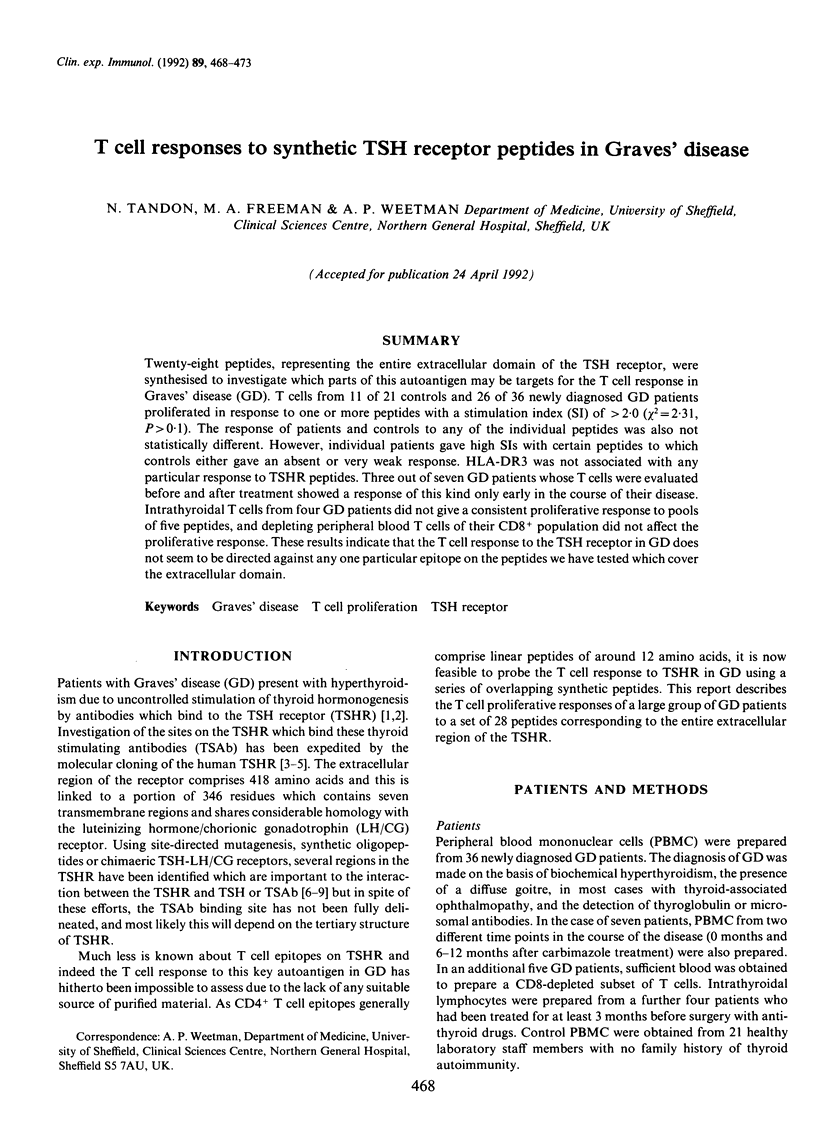
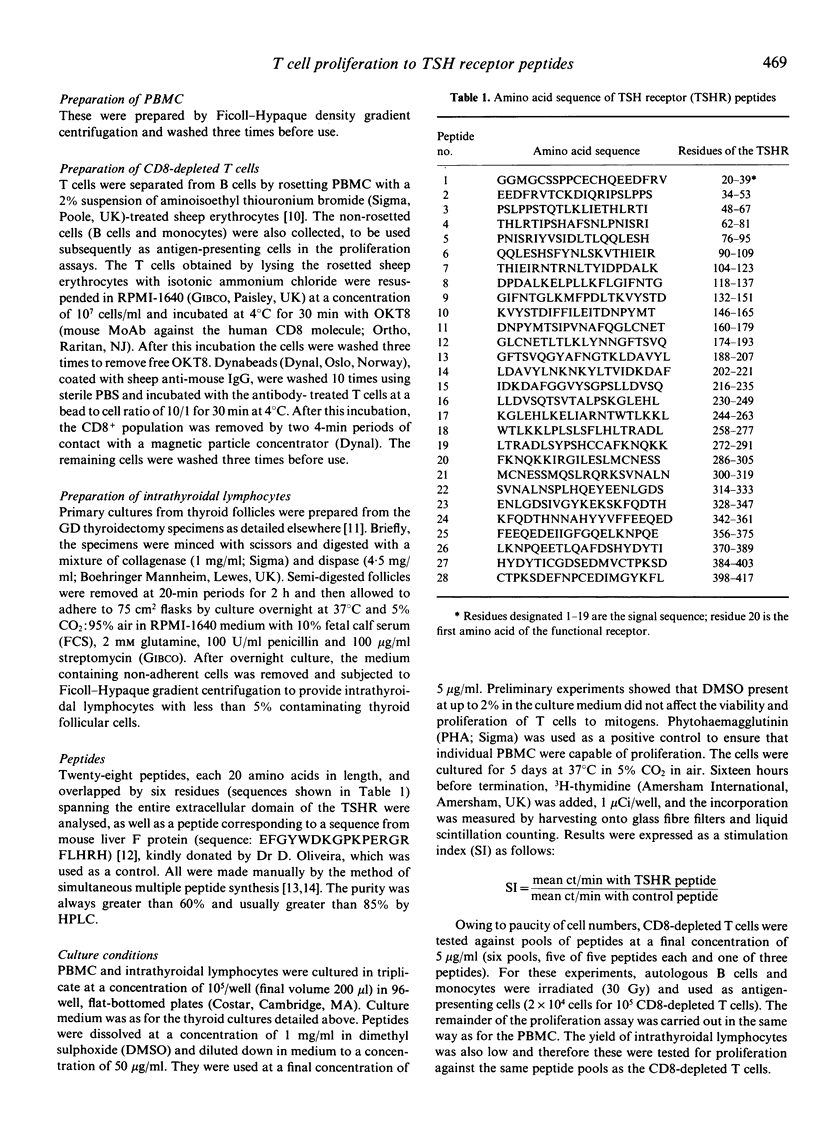
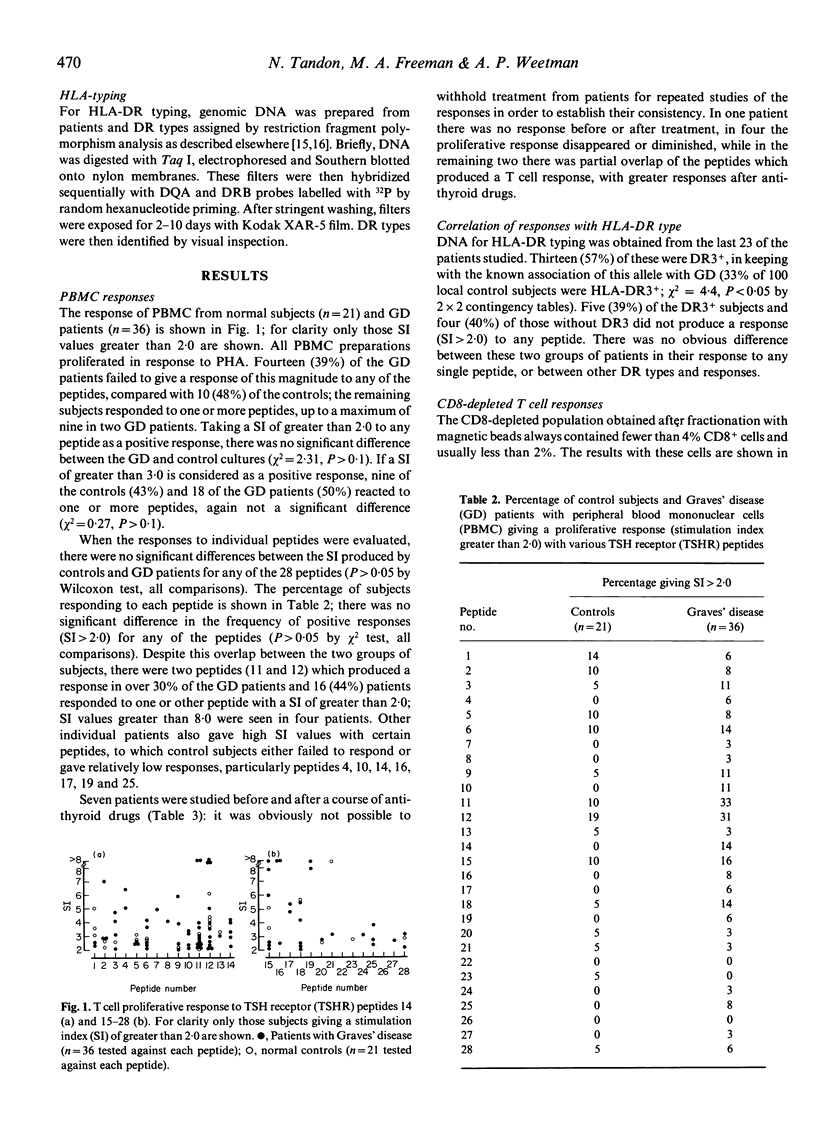
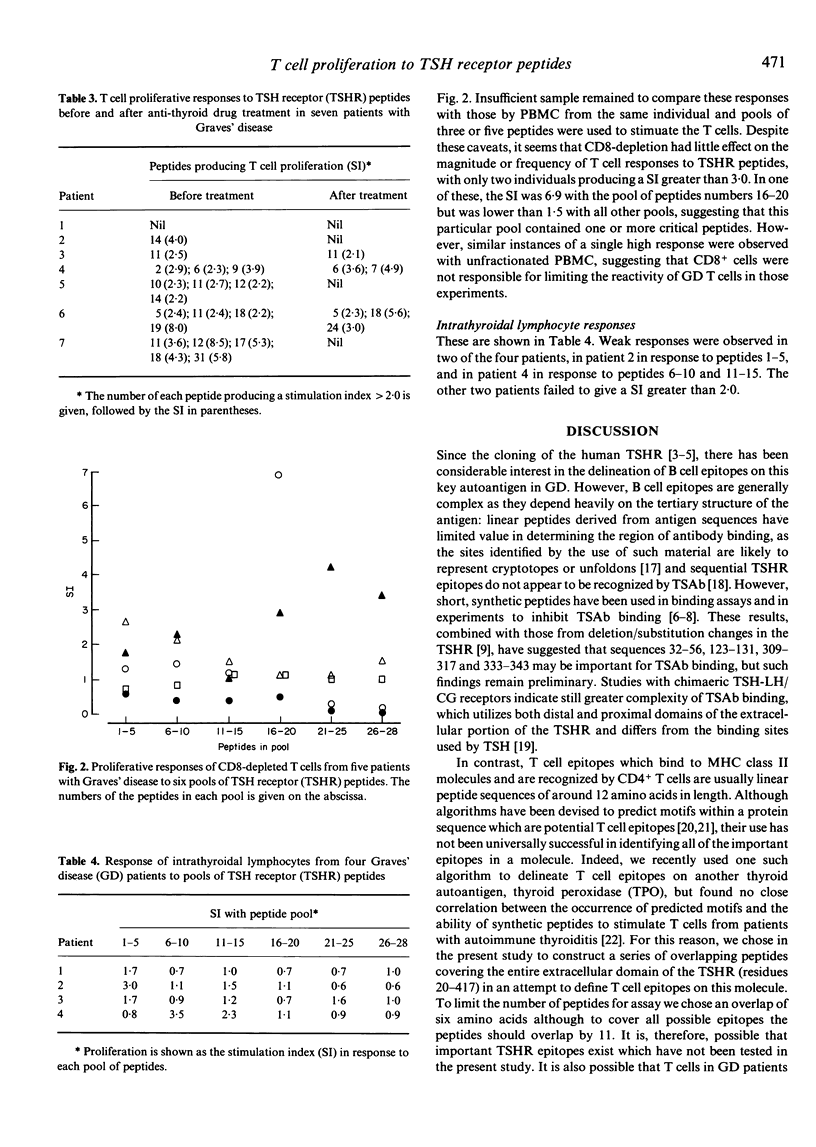
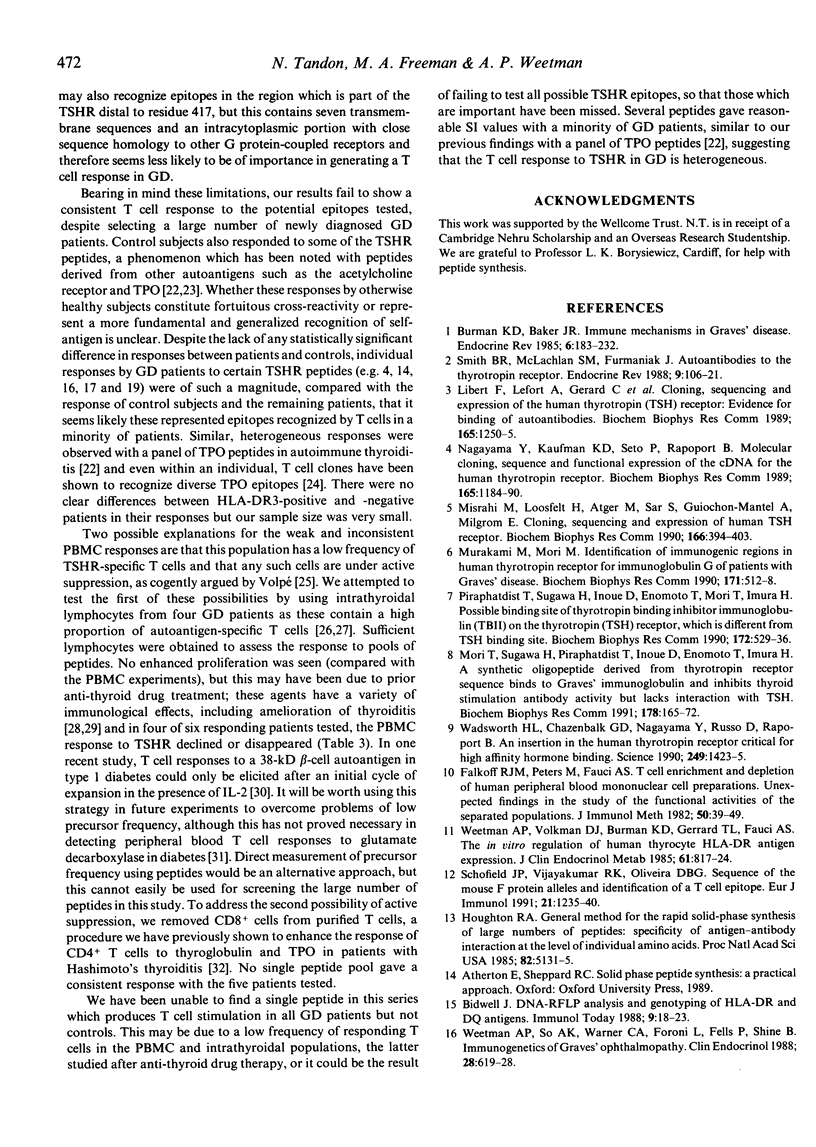
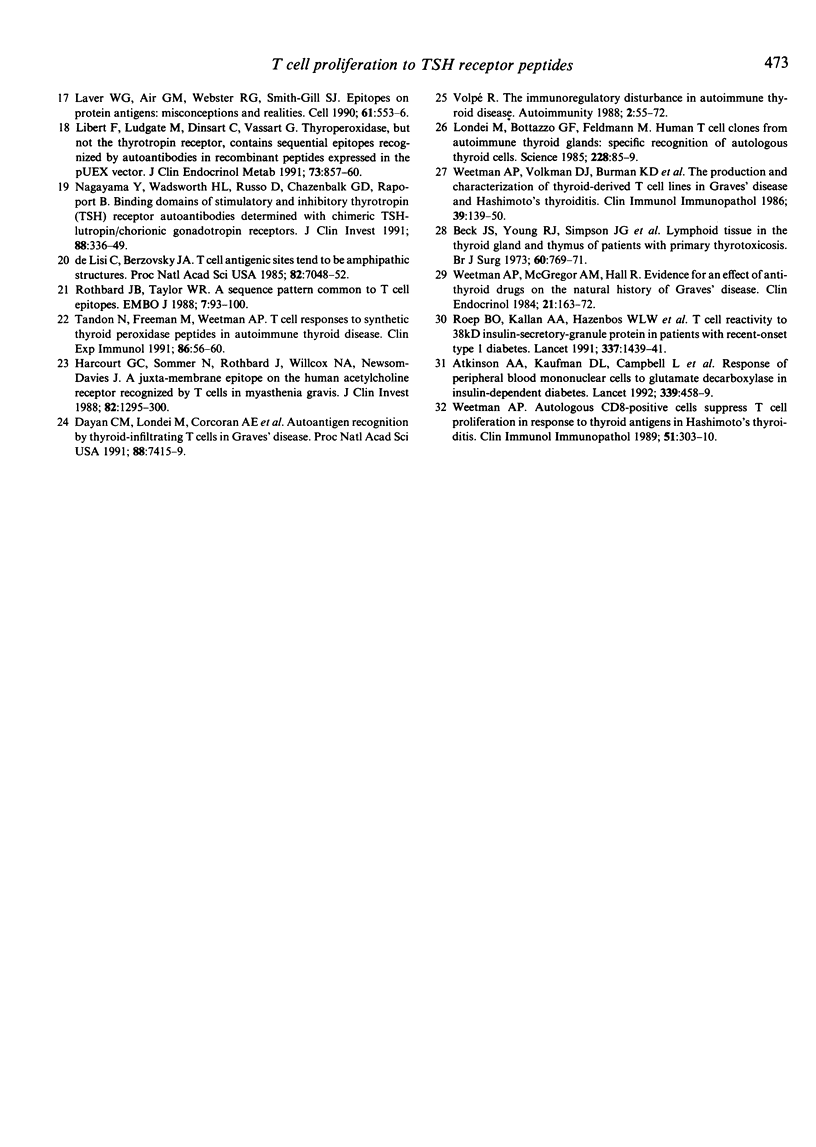
Selected References
These references are in PubMed. This may not be the complete list of references from this article.
- Atkinson M. A., Kaufman D. L., Campbell L., Gibbs K. A., Shah S. C., Bu D. F., Erlander M. G., Tobin A. J., Maclaren N. K. Response of peripheral-blood mononuclear cells to glutamate decarboxylase in insulin-dependent diabetes. Lancet. 1992 Feb 22;339(8791):458–459. doi: 10.1016/0140-6736(92)91061-c. [DOI] [PubMed] [Google Scholar]
- Beck J. S., Young R. J., Simpson J. G., Gray E. S., Nicol A. G., Pegg C. A., Michie W. Lymphoid tissue in the thyroid gland and thymus of patients with primary thyrotoxicosis. Br J Surg. 1973 Oct;60(10):769–771. doi: 10.1002/bjs.1800601005. [DOI] [PubMed] [Google Scholar]
- Bidwell J. DNA-RFLP analysis and genotyping of HLA-DR and DQ antigens. Immunol Today. 1988 Jan;9(1):18–23. doi: 10.1016/0167-5699(88)91351-5. [DOI] [PubMed] [Google Scholar]
- Burman K. D., Baker J. R., Jr Immune mechanisms in Graves' disease. Endocr Rev. 1985 Spring;6(2):183–232. doi: 10.1210/edrv-6-2-183. [DOI] [PubMed] [Google Scholar]
- Dayan C. M., Londei M., Corcoran A. E., Grubeck-Loebenstein B., James R. F., Rapoport B., Feldmann M. Autoantigen recognition by thyroid-infiltrating T cells in Graves disease. Proc Natl Acad Sci U S A. 1991 Aug 15;88(16):7415–7419. doi: 10.1073/pnas.88.16.7415. [DOI] [PMC free article] [PubMed] [Google Scholar]
- DeLisi C., Berzofsky J. A. T-cell antigenic sites tend to be amphipathic structures. Proc Natl Acad Sci U S A. 1985 Oct;82(20):7048–7052. doi: 10.1073/pnas.82.20.7048. [DOI] [PMC free article] [PubMed] [Google Scholar]
- Falkoff R. M., Peters M., Fauci A. S. T cell enrichment and depletion of human peripheral blood mononuclear cell preparations. Unexpected findings in the study of the functional activities of the separated populations. J Immunol Methods. 1982;50(1):39–49. doi: 10.1016/0022-1759(82)90302-7. [DOI] [PubMed] [Google Scholar]
- Harcourt G. C., Sommer N., Rothbard J., Willcox H. N., Newsom-Davis J. A juxta-membrane epitope on the human acetylcholine receptor recognized by T cells in myasthenia gravis. J Clin Invest. 1988 Oct;82(4):1295–1300. doi: 10.1172/JCI113729. [DOI] [PMC free article] [PubMed] [Google Scholar]
- Houghten R. A. General method for the rapid solid-phase synthesis of large numbers of peptides: specificity of antigen-antibody interaction at the level of individual amino acids. Proc Natl Acad Sci U S A. 1985 Aug;82(15):5131–5135. doi: 10.1073/pnas.82.15.5131. [DOI] [PMC free article] [PubMed] [Google Scholar]
- Laver W. G., Air G. M., Webster R. G., Smith-Gill S. J. Epitopes on protein antigens: misconceptions and realities. Cell. 1990 May 18;61(4):553–556. doi: 10.1016/0092-8674(90)90464-p. [DOI] [PubMed] [Google Scholar]
- Libert F., Lefort A., Gerard C., Parmentier M., Perret J., Ludgate M., Dumont J. E., Vassart G. Cloning, sequencing and expression of the human thyrotropin (TSH) receptor: evidence for binding of autoantibodies. Biochem Biophys Res Commun. 1989 Dec 29;165(3):1250–1255. doi: 10.1016/0006-291x(89)92736-8. [DOI] [PubMed] [Google Scholar]
- Libert F., Ludgate M., Dinsart C., Vassart G. Thyroperoxidase, but not the thyrotropin receptor, contains sequential epitopes recognized by autoantibodies in recombinant peptides expressed in the pUEX vector. J Clin Endocrinol Metab. 1991 Oct;73(4):857–860. doi: 10.1210/jcem-73-4-857. [DOI] [PubMed] [Google Scholar]
- Londei M., Bottazzo G. F., Feldmann M. Human T-cell clones from autoimmune thyroid glands: specific recognition of autologous thyroid cells. Science. 1985 Apr 5;228(4695):85–89. doi: 10.1126/science.3871967. [DOI] [PubMed] [Google Scholar]
- Misrahi M., Loosfelt H., Atger M., Sar S., Guiochon-Mantel A., Milgrom E. Cloning, sequencing and expression of human TSH receptor. Biochem Biophys Res Commun. 1990 Jan 15;166(1):394–403. doi: 10.1016/0006-291x(90)91958-u. [DOI] [PubMed] [Google Scholar]
- Mori T., Sugawa H., Piraphatdist T., Inoue D., Enomoto T., Imura H. A synthetic oligopeptide derived from human thyrotropin receptor sequence binds to Graves' immunoglobulin and inhibits thyroid stimulating antibody activity but lacks interactions with TSH. Biochem Biophys Res Commun. 1991 Jul 15;178(1):165–172. doi: 10.1016/0006-291x(91)91794-d. [DOI] [PubMed] [Google Scholar]
- Murakami M., Mori M. Identification of immunogenic regions in human thyrotropin receptor for immunoglobulin G of patients with Graves' disease. Biochem Biophys Res Commun. 1990 Aug 31;171(1):512–518. doi: 10.1016/0006-291x(90)91423-p. [DOI] [PubMed] [Google Scholar]
- Nagayama Y., Kaufman K. D., Seto P., Rapoport B. Molecular cloning, sequence and functional expression of the cDNA for the human thyrotropin receptor. Biochem Biophys Res Commun. 1989 Dec 29;165(3):1184–1190. doi: 10.1016/0006-291x(89)92727-7. [DOI] [PubMed] [Google Scholar]
- Nagayama Y., Wadsworth H. L., Russo D., Chazenbalk G. D., Rapoport B. Binding domains of stimulatory and inhibitory thyrotropin (TSH) receptor autoantibodies determined with chimeric TSH-lutropin/chorionic gonadotropin receptors. J Clin Invest. 1991 Jul;88(1):336–340. doi: 10.1172/JCI115297. [DOI] [PMC free article] [PubMed] [Google Scholar]
- Piraphatdist T., Sugawa H., Inoue D., Enomoto T., Mori T., Imura H. Possible binding site of thyrotropin binding inhibitor immunoglobulin (TBII) on the thyrotropin (TSH) receptor, which is different from TSH binding site. Biochem Biophys Res Commun. 1990 Oct 30;172(2):529–536. doi: 10.1016/0006-291x(90)90705-r. [DOI] [PubMed] [Google Scholar]
- Rees Smith B., McLachlan S. M., Furmaniak J. Autoantibodies to the thyrotropin receptor. Endocr Rev. 1988 Feb;9(1):106–121. doi: 10.1210/edrv-9-1-106. [DOI] [PubMed] [Google Scholar]
- Roep B. O., Kallan A. A., Hazenbos W. L., Bruining G. J., Bailyes E. M., Arden S. D., Hutton J. C., de Vries R. R. T-cell reactivity to 38 kD insulin-secretory-granule protein in patients with recent-onset type 1 diabetes. Lancet. 1991 Jun 15;337(8755):1439–1441. doi: 10.1016/0140-6736(91)93127-u. [DOI] [PubMed] [Google Scholar]
- Rothbard J. B., Taylor W. R. A sequence pattern common to T cell epitopes. EMBO J. 1988 Jan;7(1):93–100. doi: 10.1002/j.1460-2075.1988.tb02787.x. [DOI] [PMC free article] [PubMed] [Google Scholar]
- Schofield J. P., Vijayakumar R. K., Oliveira D. B. Sequences of the mouse F protein alleles and identification of a T cell epitope. Eur J Immunol. 1991 May;21(5):1235–1240. doi: 10.1002/eji.1830210521. [DOI] [PubMed] [Google Scholar]
- Tandon N., Freeman M., Weetman A. P. T cell responses to synthetic thyroid peroxidase peptides in autoimmune thyroid disease. Clin Exp Immunol. 1991 Oct;86(1):56–60. doi: 10.1111/j.1365-2249.1991.tb05773.x. [DOI] [PMC free article] [PubMed] [Google Scholar]
- Wadsworth H. L., Chazenbalk G. D., Nagayama Y., Russo D., Rapoport B. An insertion in the human thyrotropin receptor critical for high affinity hormone binding. Science. 1990 Sep 21;249(4975):1423–1425. doi: 10.1126/science.2169649. [DOI] [PubMed] [Google Scholar]
- Weetman A. P. Autologous CD8-positive cells suppress T cell proliferation in response to thyroid antigens in Hashimoto's thyroiditis. Clin Immunol Immunopathol. 1989 May;51(2):303–310. doi: 10.1016/0090-1229(89)90028-7. [DOI] [PubMed] [Google Scholar]
- Weetman A. P., McGregor A. M., Hall R. Evidence for an effect of antithyroid drugs on the natural history of Graves' disease. Clin Endocrinol (Oxf) 1984 Aug;21(2):163–172. doi: 10.1111/j.1365-2265.1984.tb03456.x. [DOI] [PubMed] [Google Scholar]
- Weetman A. P., So A. K., Warner C. A., Foroni L., Fells P., Shine B. Immunogenetics of Graves' ophthalmopathy. Clin Endocrinol (Oxf) 1988 Jun;28(6):619–628. doi: 10.1111/j.1365-2265.1988.tb03853.x. [DOI] [PubMed] [Google Scholar]
- Weetman A. P., Volkman D. J., Burman K. D., Gerrard T. L., Fauci A. S. The in vitro regulation of human thyrocyte HLA-DR antigen expression. J Clin Endocrinol Metab. 1985 Nov;61(5):817–824. doi: 10.1210/jcem-61-5-817. [DOI] [PubMed] [Google Scholar]
- Weetman A. P., Volkman D. J., Burman K. D., Margolick J. B., Petrick P., Weintraub B. D., Fauci A. S. The production and characterization of thyroid-derived T-cell lines in Graves' disease and Hashimoto's thyroiditis. Clin Immunol Immunopathol. 1986 Apr;39(1):139–150. doi: 10.1016/0090-1229(86)90213-8. [DOI] [PubMed] [Google Scholar]


